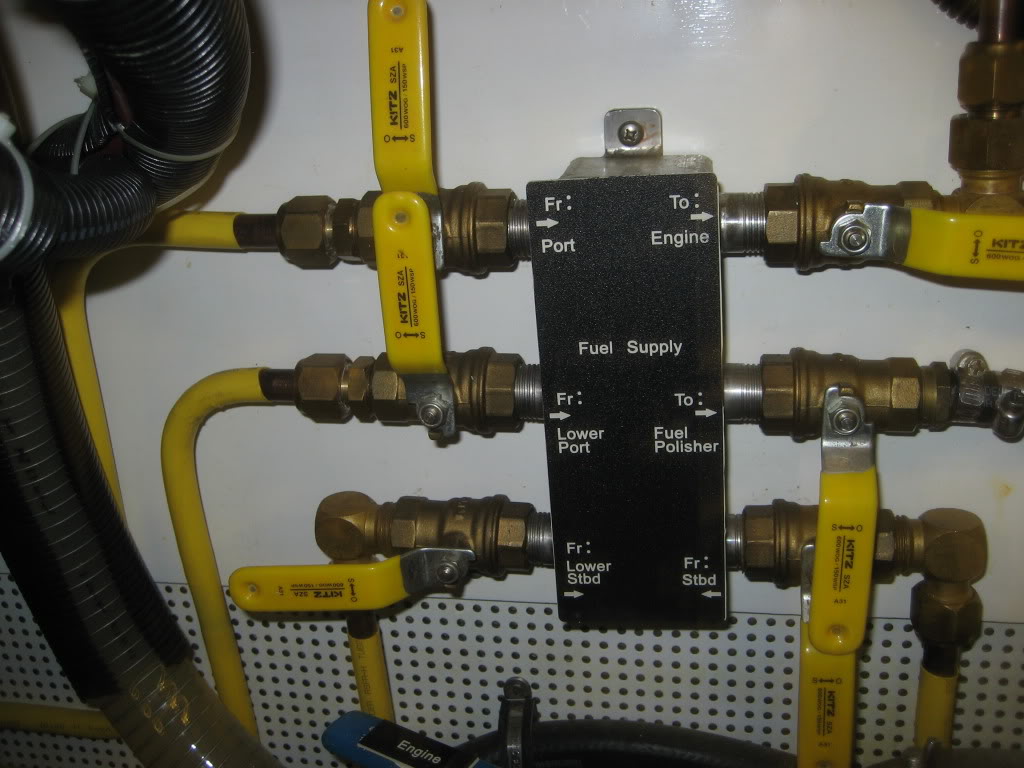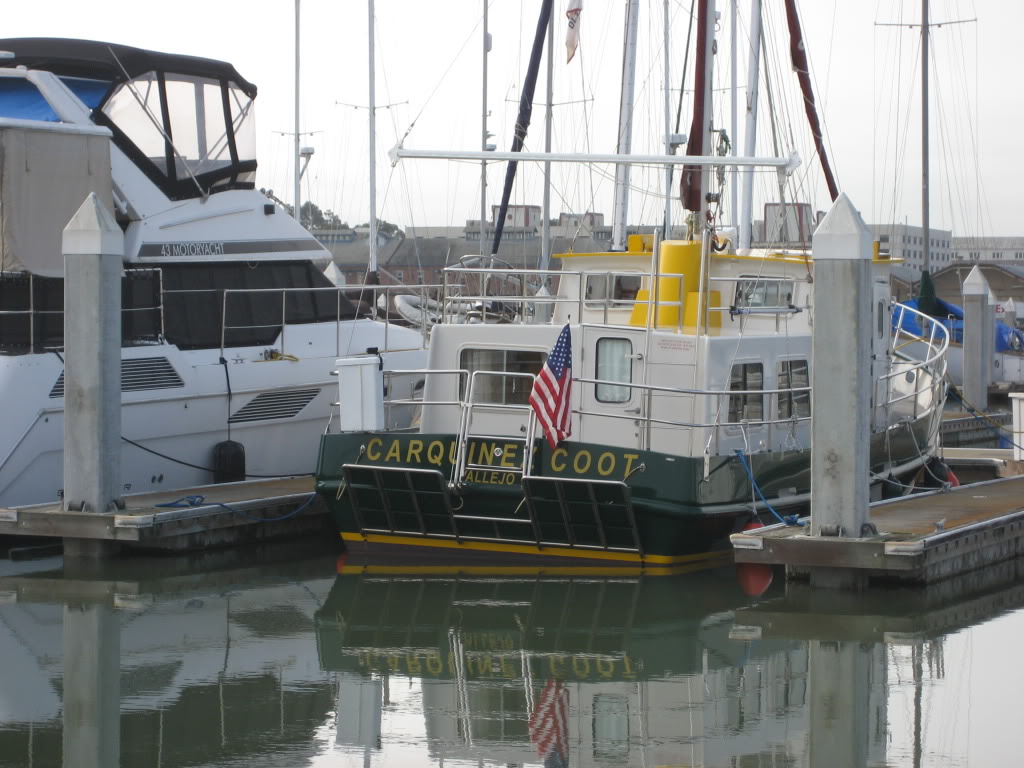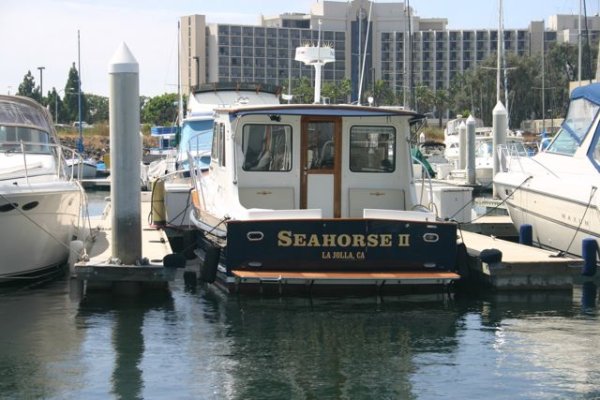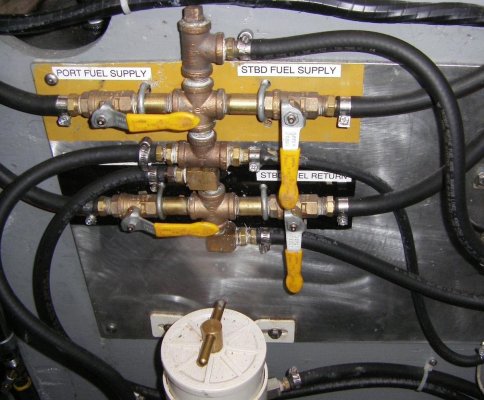You are using an out of date browser. It may not display this or other websites correctly.
You should upgrade or use an alternative browser.
You should upgrade or use an alternative browser.
Fuel Selector
- Thread starter tpbrady
- Start date
The friendliest place on the web for anyone who enjoys boating.
If you have answers, please help by responding to the unanswered posts.
If you have answers, please help by responding to the unanswered posts.
A parallel plumbed system will always have some bit of assymetry which will cause most of the fuel to be drawn from one tank. And the same lack of symmetry will send most of the return fuel to one tank, but not necessarily the same one.
I prefer to run on one tank for a while until trim gets noticeable and then switch to the other one. That way you are sure which tank is supplying the fuel.
David
I prefer to run on one tank for a while until trim gets noticeable and then switch to the other one. That way you are sure which tank is supplying the fuel.
David
markpierce
Master and Commander
- Joined
- Sep 25, 2010
- Messages
- 12,557
- Location
- USA
- Vessel Name
- Carquinez Coot
- Vessel Make
- penultimate Seahorse Marine Coot hull #6
David, thanks for reminding me why I draw fuel from only one tank at a time.


Codger2
Guru
- Joined
- Oct 11, 2007
- Messages
- 6,691
- Location
- US
- Vessel Name
- Circuit Breaker
- Vessel Make
- 2021..22' Duffy Cuddy cabin
A parallel plumbed system will always have some bit of assymetry which will cause most of the fuel to be drawn from one tank. And the same lack of symmetry will send most of the return fuel to one tank, but not necessarily the same one.
 But on my boat, as fuel levels approach the half way mark, the list is much less pronounced. ?????
But on my boat, as fuel levels approach the half way mark, the list is much less pronounced. ?????Attachments
Last edited:
markpierce
Master and Commander
- Joined
- Sep 25, 2010
- Messages
- 12,557
- Location
- USA
- Vessel Name
- Carquinez Coot
- Vessel Make
- penultimate Seahorse Marine Coot hull #6
This is what happens when loading tanks on only one side:


Tom.B
Moderator Emeritus
- Joined
- Jul 30, 2009
- Messages
- 5,839
- Location
- USA
- Vessel Name
- Skinny Dippin'
- Vessel Make
- Navigator 4200 Classic
While I *can* select to to and from tanks on my manifold, I never do. I draw from both and return to both. It always seem to burn almost even from both tanks. If one gets a little ahead, the other catches up shortly with no intervention from me.
Having accidentally had fuel return to the "wrong" tank, I am always VERY careful now to ensure that flow is only in and out of the same tank. Even on a long run (24 hours) you are only talking about burning something like 60 gallons (500lb) of fuel. Enough to cause only a slight trim change for a heavy trawler. Much safer to control the flow rather than assume gravity is doing it for you. Plus, if return flow ever does cause one tank to get more flow than the other, then the situation can possibly get out of hand. The preferred tank will conceivably fill at a faster and faster rate (because that side of the boat is tilting down due to increased fuel weight) until it may overflow!!
Tom.B
Moderator Emeritus
- Joined
- Jul 30, 2009
- Messages
- 5,839
- Location
- USA
- Vessel Name
- Skinny Dippin'
- Vessel Make
- Navigator 4200 Classic
Isn't the return just a small fraction of what is sent? In other words, wouldn't the return on a 60-gallon day be just a few gallons? I have never measured it. Would be interested to know what the numbers are.
SomeSailor
Guru
- Joined
- Oct 22, 2011
- Messages
- 784
- Vessel Name
- Honey Badger
- Vessel Make
- 42' CHB Europa
I draw from and return to the same tank, but have gravity transfer valves that can be opened to adjust trim if necessary. After winter, I'm usually lighter on the side my heater draws from. I simply dump my water from the opposite side (1,200 pounds) and open the transfer valves until the levels are equal. Having large outboard potable tanks makes it simple.
Codger2
Guru
- Joined
- Oct 11, 2007
- Messages
- 6,691
- Location
- US
- Vessel Name
- Circuit Breaker
- Vessel Make
- 2021..22' Duffy Cuddy cabin
No. Depending on the engine the fuel return is usually much more than the fuel burned.
That's certainly the case on my boat which is why I route the return line to the tank I draw from. Doing this, I know I won't be sending fuel to a full tank, resulting in a spill from that tank's vent.
Nomad Willy
Guru
I always draw and return to one tank.
If you have gravity transfer fuel to the "low" side it will become lower and then more will transfer ............. and on and on. But usually not much list results but what if there was another force involved like a strong crosswind. That ma amplify things considerably and then what if you were running down a narrow channel in that strong wind and suddenly ran out into a very rough bay. That amplified downwind list will not be an asset in the sharp beam seas in the bay.
The above is hypothetical of course but given enough time something like that will happen. Kinda like a single engine quitting. I personally like to have control over such matters and my very slight list w full tanks invites me to start drawing from the low side.
My fuel manifold system is very similar to Marks but not so pretty and new looking for obvious reasons.
If you have gravity transfer fuel to the "low" side it will become lower and then more will transfer ............. and on and on. But usually not much list results but what if there was another force involved like a strong crosswind. That ma amplify things considerably and then what if you were running down a narrow channel in that strong wind and suddenly ran out into a very rough bay. That amplified downwind list will not be an asset in the sharp beam seas in the bay.
The above is hypothetical of course but given enough time something like that will happen. Kinda like a single engine quitting. I personally like to have control over such matters and my very slight list w full tanks invites me to start drawing from the low side.
My fuel manifold system is very similar to Marks but not so pretty and new looking for obvious reasons.
Attachments
supertramp
Senior Member
- Joined
- Sep 28, 2008
- Messages
- 150
- Location
- Cubazuela
- Vessel Name
- " Supertramp "
- Vessel Make
- Marine Trader Widebody 50 feet
My situation:
Starboard-Motor with starbord-Maintank,
Port-Motor with port-Maintank.
Keeltank es the trim-depod, from here works the Fuelpump o gravity to the 6 Tanks-also retorn.
In total i have 6 tanks and over 5000 Liter diesel when the tanks are full.
_____________________
Norbert
Starboard-Motor with starbord-Maintank,
Port-Motor with port-Maintank.
Keeltank es the trim-depod, from here works the Fuelpump o gravity to the 6 Tanks-also retorn.
In total i have 6 tanks and over 5000 Liter diesel when the tanks are full.
_____________________
Norbert
Last edited:
While I *can* select to to and from tanks on my manifold, I never do. I draw from both and return to both. It always seem to burn almost even from both tanks. If one gets a little ahead, the other catches up shortly with no intervention from me.
There's a lot to be said for the "KISS" (Keep It Simple, Stupid) principle.
Our two Fords normally feed from the 60 gallon day tank that is on the centerline of the boat. While the fuel return from the Ford Dorset is so little as to be almost non-existant, it is normally fed back to the day tank.
Te day tank is filled manually by using valves and gravity from the four saddle tanks. So we can affect the lateral trim of the boat if necessary using the saddle tanks. So far this has not proved necessary.
The engines can feed from and return to any tank(s) on the boat so in the event of a problem with the day tank feed the engines can be valved to other tanks. But since all the tanks including the day tank feed by gravity from their lowest points there is little or nothing that can interfere with the fuel flow other than a frozen valve or a hose problem.
As Ron mentioned earlier, there is much to be said for the KISS principle when it comes to the fuel system on a boat.
Te day tank is filled manually by using valves and gravity from the four saddle tanks. So we can affect the lateral trim of the boat if necessary using the saddle tanks. So far this has not proved necessary.
The engines can feed from and return to any tank(s) on the boat so in the event of a problem with the day tank feed the engines can be valved to other tanks. But since all the tanks including the day tank feed by gravity from their lowest points there is little or nothing that can interfere with the fuel flow other than a frozen valve or a hose problem.
As Ron mentioned earlier, there is much to be said for the KISS principle when it comes to the fuel system on a boat.
psneeld
Guru
When travelling where fuel could be suspect...many operators will only fill one side at a time and run from one side. That way if the fuel is bad, you have options...
That said I have never gotten bad fuel in the states or Bahamas for over 50 years of boating. But I have heard horror stories including a friend of mine that flamed out both helo engines between the fuel truck and the runway due to 20 gallons of water!!!
That said I have never gotten bad fuel in the states or Bahamas for over 50 years of boating. But I have heard horror stories including a friend of mine that flamed out both helo engines between the fuel truck and the runway due to 20 gallons of water!!!
Last edited:
LaBomba
Guru
- Joined
- Nov 18, 2012
- Messages
- 1,240
- Location
- Canada
- Vessel Name
- Looking Glass
- Vessel Make
- Carver 370 Voyager
When travelling where fuel could be suspect...many operators will only fill one side at a time and run from one side. That way if the fuel is bad, you have options...
That said I have never gotten bad fuel in the states or Bahamas for over 50 years of boating. But I have heard horror stories including a friend of mine that flamed out both helo engines between the fuel truck and the runway due to 20 gallons of water!!!
I'm in your camp. I have never had bad fuel but heard stories so I stay on the safe side and fill one tank at a time and run and return to one at a time. This way I have one "clean" tank to switch to if things go south.
psneeld
Guru
Obviously those that have a day tank are in a different boat...
But hopefully it isn't so large that it couldn't be quickly emptied or bypassed if contaminated (but in most cases a good filtration system to it is the answer anyway so problems should be rare to non-existent)
But hopefully it isn't so large that it couldn't be quickly emptied or bypassed if contaminated (but in most cases a good filtration system to it is the answer anyway so problems should be rare to non-existent)
Obelikx
Veteran Member
- Joined
- May 19, 2012
- Messages
- 29
- Location
- Netherlands
- Vessel Name
- Obelikx
- Vessel Make
- De Klerk Kotter
Assuming a vessel is sitting level port to starboard, with port and starboard fuel tanks, should you have the fuel selector set to take fuel from both tanks to maintain trim?
Tom
In addition to the fuel selector lines, I have a connection between port and starboard tanks which I normally keep open to prevent overfilling of one tank in case that the return line drains to the other tank ( which easily could happen after dome dumbo ( me) puts one of the stopcocks in the wrong position)
And yes I do have a day tank, but only use it directly after refueling and if in doubt in heavy weather and for checking fuel consumption - the day tank mainly adds to complexity, creating chances for new mistakes ( like keeping the return line switched to one of the main tanks ...)
In my experience if you create a possibility for stupid mistakes, eventually you make them.
In my boat the open connection line does not result in significant listening, but that will not work if you need different levels to maintain the trim.
Tom.B
Moderator Emeritus
- Joined
- Jul 30, 2009
- Messages
- 5,839
- Location
- USA
- Vessel Name
- Skinny Dippin'
- Vessel Make
- Navigator 4200 Classic
I want to add that up until two years ago when I completely overhauled Skinny Dippin's fuel system, she drew fuel from both and returned to only one. I never noticed anything out of the ordinary from the standpoint of unequal fill. That's weird.
I looked at my engine manual and could find a reference to ratio of burn-to-return, but I will look again. I got sidetracked by some other stuff I needed to look up. DOH!
I looked at my engine manual and could find a reference to ratio of burn-to-return, but I will look again. I got sidetracked by some other stuff I needed to look up. DOH!
Here is an old reference discussion on this topic:
Fuel Return Ratio - SailNet Community
Seems like the return ratio can vary quite a bit from 1:1 (fuel burned to fuel returned) to 4:1 or 5:1 depending on the engine HP, configuration, manufacturer, etc.
Also relevant to fuel filtration since all that returned fuel is flowing through your filters and back to your tank. One way to help keep fuel clean via your Racors.
Fuel Return Ratio - SailNet Community
Seems like the return ratio can vary quite a bit from 1:1 (fuel burned to fuel returned) to 4:1 or 5:1 depending on the engine HP, configuration, manufacturer, etc.
Also relevant to fuel filtration since all that returned fuel is flowing through your filters and back to your tank. One way to help keep fuel clean via your Racors.
supertramp
Senior Member
- Joined
- Sep 28, 2008
- Messages
- 150
- Location
- Cubazuela
- Vessel Name
- " Supertramp "
- Vessel Make
- Marine Trader Widebody 50 feet
in my case the return goes back into the filter but if the return is too large, you cooled the diesel- backline with an intercooler.
This is on bigboats normal.
___________________
Norbert
This is on bigboats normal.
___________________
Norbert
With 4 tanks, I'm thinking I'll run one engine on it's fwd tank, and the other on it's aft tank. For example, port engine on fwd port tank and stb engine on stb aft tank. Or vice-versa.
When I fuel up, I'll switch to the opposite tanks and run from those until the next fill.
My theory is that I'll always have two tanks that weren't filled at the same time and place, just in case.
Returns will always go to the same tank I'm drawing from.
I haven't had a chance to put any of this into practice yet. Another 6"-18" of snow is predicted for tomorrow
When I fuel up, I'll switch to the opposite tanks and run from those until the next fill.
My theory is that I'll always have two tanks that weren't filled at the same time and place, just in case.
Returns will always go to the same tank I'm drawing from.
I haven't had a chance to put any of this into practice yet. Another 6"-18" of snow is predicted for tomorrow
Do you keep another tank ready for the lobsters??
Hmmmm... I could convert the centerline 213 gallon potable water tank to a lobster holding tank pretty easily. Now, what would I find to drink?...
Hey everyone. I just climbed out of the engine room (36 Heritage Sundeck, single 5.9 cummins, with tanks port and starboard. I see where the fuel goes into the tanks, I see where the fuel goes from the top of the tank to the RACOR, and I see another line that I assume is the return (goes from engine block up to the top, next to the line that feeds the RACOR. What I DON'T see is how I can shut off the cross-over flow of fuel from the port to starboard. Again, I put 50 gals in port and it moved to starboard tank. I don't see a shut off value BETWEEN the tanks - I see a shut off at the bottom of each tank that the visual tubes are connected to, and I see a shut off from the fuel lines to the RACOR. What am I missing?
Listing in Alameda!
Listing in Alameda!
.............. I see where the fuel goes from the top of the tank to the RACOR, ......
Doesn't the fuel come from both tanks into the filter? At some point, the lines from each tank join and feed the filter. That would be your crossover. You don't necessarily have a separate crossover tube or line. There should be a valve to valve off each tank. Somewhere, there should be a valve or valves that direct the return flow to either or both tanks.
BTW: Fuel is not coming from the top of the tank, there is a dip tube that goes to the bottom. Otherwise you would draw air, not fuel.
Similar threads
- Replies
- 4
- Views
- 285


